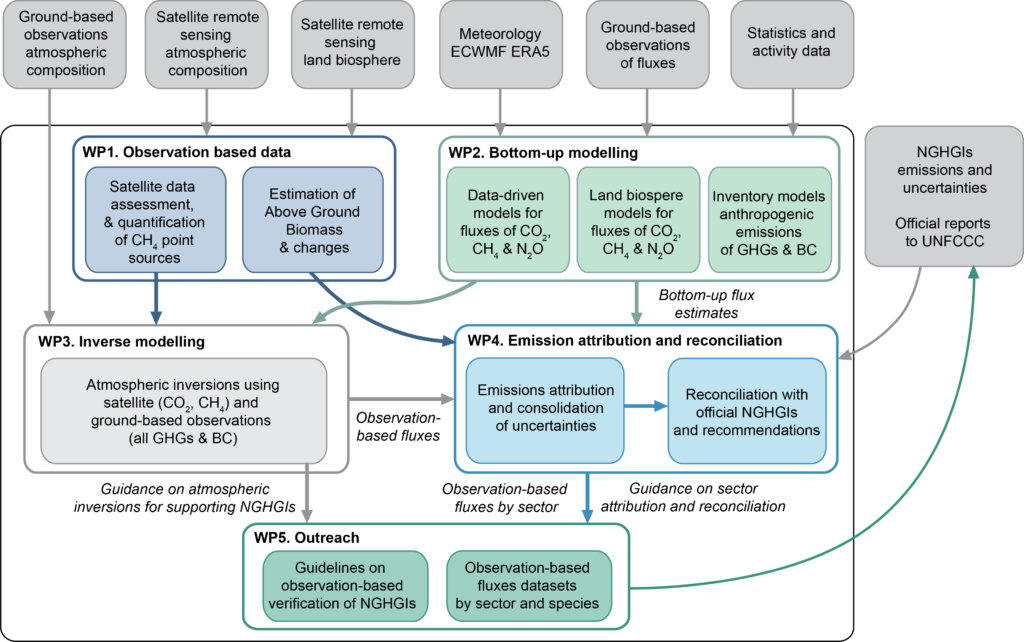
ABOUT THE PROJECT
OVERVIEW
EYE-CLIMA is a Research and Innovation project funded under the Horizon Europe programme of the European Commission. The project was funded under the call on “Verification and reconciliation of estimates of climate forcers” in cluster 5, “Climate, Energy and Mobility”.
EYE-CLIMA is coordinated by the Climate and Environmental Research Institute NILU and has 17 partners in 8 European countries. The project runs from January 2023 to December 2026.
CONTEXT
The Paris Agreement aims to limit global warming to well below 2°C, and preferably to below 1.5°C, by reducing emissions of greenhouse gases (GHGs) globally. Progress towards this target will be monitored through a process known as the Global Stocktake in which the progress on emissions reductions will be assessed every 5-years (the first is to be completed in 2023).
Currently, progress is assessed by National Greenhouse Gas inventories (NGHGIs) for Annex-I countries and Biennial Update Reports for non-Annex-I. However, these emission inventories/reports suffer from lack of frequency (especially for non-Annex-I countries) and inherent uncertainties. Therefore, there is a strong interest in having independent information on progress towards emission reductions based on observations of the atmospheric concentration of the different GHGs – from satellites as well as from ground-based networks. Changes in atmospheric concentrations represent the integrated effect of human emissions, natural fluxes, atmospheric transport, and any atmospheric production and loss. Thus, by accounting for atmospheric production and loss, changes in concentrations can be used to constrain human emissions and natural fluxes. This is known as the “top-down” method.
There are already a number of initiatives looking into the use of top-down methods to inform on emissions and removals, such as the uptake of CO2 by the land-biosphere. EYE-CLIMA aims to improve the method to a level of readiness where it can be used to inform about emissions at national and sub-national scales, including estimation of the emissions uncertainties. In doing so, EYE-CLIMA will support European and national policies on reducing emissions and enhancing removals.
EYE-CLIMA will focus on the medium and long-lived GHGs: CO2, CH4, N2O and the halogenated gases, HFC-134a, HFC-23, HFC-125, HFC-143a, HFC-32 and SF6. In addition, EYE-CLIMA will look at black carbon (BC) – the only aerosol with a positive (but very uncertain) direct contribution to warming.

OBJECTIVES
EYE-CLIMA’s overarching objective is to address the need for independent verification of NGHGIs by developing observation-based methods for determining emissions at national and sub-national scales.
EYE-CLIMA’s specific objectives are:
- Develop the atmospheric inversion methodology to operationally support NGHGIs
- Establish guidelines on how to perform atmospheric inversions and evaluate the results
- Better understand the needs of NGHGI compilers by working together in pilot projects
- Develop methodologies to detect and quantify large emissions of CH4 using high resolution satellite data
- Improve estimates of CO2 land biosphere fluxes and emissions and removals of CO2 in the LULUCF sector
- Support the implementation and monitoring of EU policy through providing accurate estimates of GHG fluxes and BC emissions
STRUCTURE
EYE-CLIMA is structured into four scientific work packages (WPs), one outreach WP and one coordination WP. The scientific WPs are organised by methodological step.
WP1. Observation based data
WP1 deals with observation data products including those of the land-biosphere and of atmospheric composition and will be used as input to WP2 and WP3. WP1 will examine data from existing and new satellite missions for CH4 and use these to identify and quantify large emission sources using machine learning and atmospheric transport modelling. WP1 will also examine observations of equivalent black carbon (eBC) from photometers and use these to partition BC into traffic and non-traffic sources.
WP2. Bottom-up modelling
WP2 will estimate land fluxes of CO2, CH4 and N2O from natural and anthropogenic sources and emissions of F-gases and BC, including their uncertainties. These estimates will be used as prior information in atmospheric inversions in WP3 and to support the attribution of the top-down fluxes to source sectors in WP4. The fluxes of CO2, CH4 and N2O will be estimated using land-surface models (LSMs), which mechanistically describe the interactions of soil, hydrology, vegetation and management, and their effect on land-atmosphere fluxes of carbon and nitrogen species. For each of these three species, the fluxes will be estimated from two different models (using the same input data and protocols) to gain an insight into the structural uncertainties. In addition, comparisons with data-driven approaches will be made to better quantify flux uncertainties. For each GHG, ensembles of runs with each model will also be made by varying a few key drivers to determine the uncertainty in fluxes due to these.
WP3. Inverse modelling
WP3 will use atmospheric inverse modelling to integrate bottom-up information (from WP2) with observations and provide top-down flux estimates for informing EU policy and for supporting national emission inventories (in WP4). A secondary objective in WP3 is to provide a detailed assessment of the uncertainty in the top-down flux estimates and best practice guidelines on how to run inversions to support national emission inventories.
WP4. Emission attribution and reconciliation
WP4 will focus on the attribution of the fluxes to source types by analysing the spatiotemporal patterns of the fluxes and through using auxiliary information. For CH4, some constraint by source type is possible by including its stable isotopes (δ13C) in atmospheric inversions (in WP3). WP4 also will estimate the uncertainty for each species and sector by consolidating the uncertainties in the different datasets used in the emission estimates. Furthermore, pilot projects will be carried-out for France, Germany and Finland in collaboration with national GHG inventory compilers for each of these countries, the aim of which is to provide a detailed reconciliation of top-down and national inventories estimates. Lastly, a synthesis of GHG and BC emissions for Europe will be prepared.
WP5. Outreach
WP5 will disseminate and communicate EYE-CLIMA results to scientists, NGHGI compilers, national and EU policy makers, and the general public to ensure maximum impact. Furthermore, WP5 will organize consultations with users to have their input into designing data products that suit their needs.

